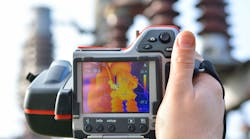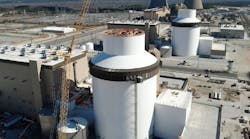Marking a first for U.S. utilities, the New York Power Authority is now utilizing a new online infrared camera system at its largest power plant, the Niagara Power Project, to detect any potential situations of concern with operations and to assess how data readings for infrared cameras are affected by weather.
This camera pilot study, which also uses weather sensors to estimate thermal measurements, is intended to help utilities develop more accurate, efficient and cost-effective ways to identify potential operational problems, thus improving service and avoiding unplanned, and potentially costly, outages. “Utilities need to continually and accurately monitor power sub-stations and switchyards regardless of weather conditions,” said Alan Ettlinger, director of research, technology development and innovation at NYPA. “Technologies are quickly advancing and this new system has the potential to greatly improve our collection and analysis of data while boosting our inspection and assessment programs.”
Infrared imaging is already used to monitor power substations and transmission switchyards because of its electric fault detection capabilities. However, the process can be time consuming as most units currently being used are portable and require manual operation and data analysis. Electric utilities are interested in finding a more cost-effective technology that can generate more accurate and timely data and be deployed in a more regular and independent manner. For this project, the infrared camera, which identifies hot spots and indicates any problems, was installed in a fixed position to monitor a transformer.
This technology helps advance Governor Cuomo’s Reforming the Energy Vision (REV) strategy to build a cleaner, more resilient and affordable energy system for all New Yorkers.
The Electric Power and Research Institute (EPRI) is collecting and interpreting the project data.
In addition to the infrared camera, adjacent sensors have been added to create a “weather station” for the collection of environmental data. The project also involves testing ten different types of sensors, provided by EPRI, to see which work best.
An earlier phase of the project involved installing an infrared camera on a transformer at NYPA’s Harlem River power substation. As a result of that project, EPRI developed a laboratory system for developing the algorithms and installed several field demonstration systems that collect infrared measurements of substation equipment, local weather data and equipment temperature. The information is sent over a wireless network to EPRI’s Charlotte laboratory where the data is analyzed to confirm that the infrared camera is accurately reading transformer conditions.
This next phase in the project will further research and develop algorithms that can correct, to the degree possible, thermal measurement accuracy and help alert users to conditions in station equipment before they result in a failure. A new alarm feature will also give an automatic notification if the temperature of equipment rises higher than a pre-determined limit, indicating a potential equipment problem that needs to be addressed.
Information from the camera is also being fed into NYPA’s recently announced transformer asset health system where it is combined with data from other sensors and put into an algorithm to predict the overall health of the transformer.
If this project is successful, NYPA plans to increase the use of infrared cameras on its other transformers.


